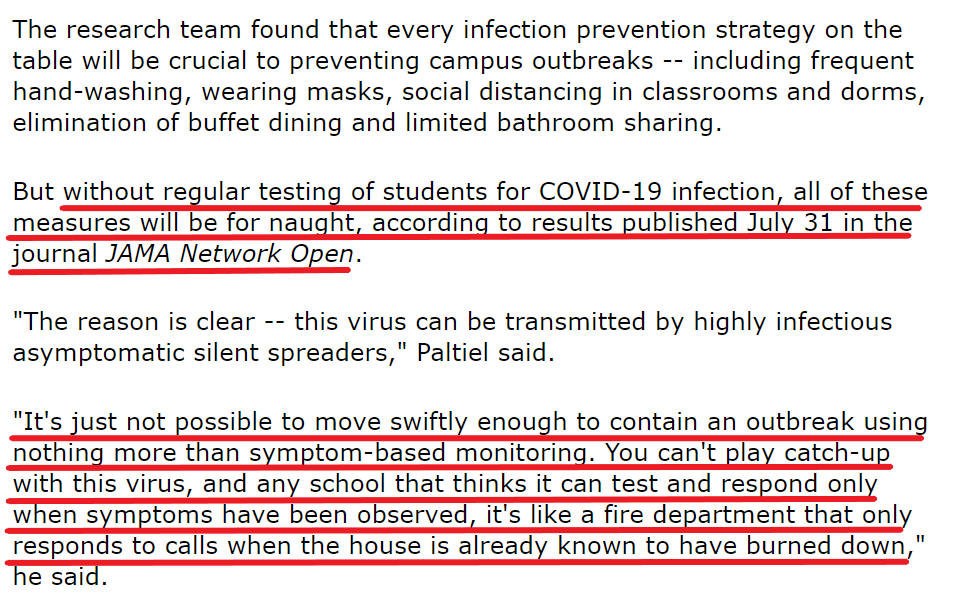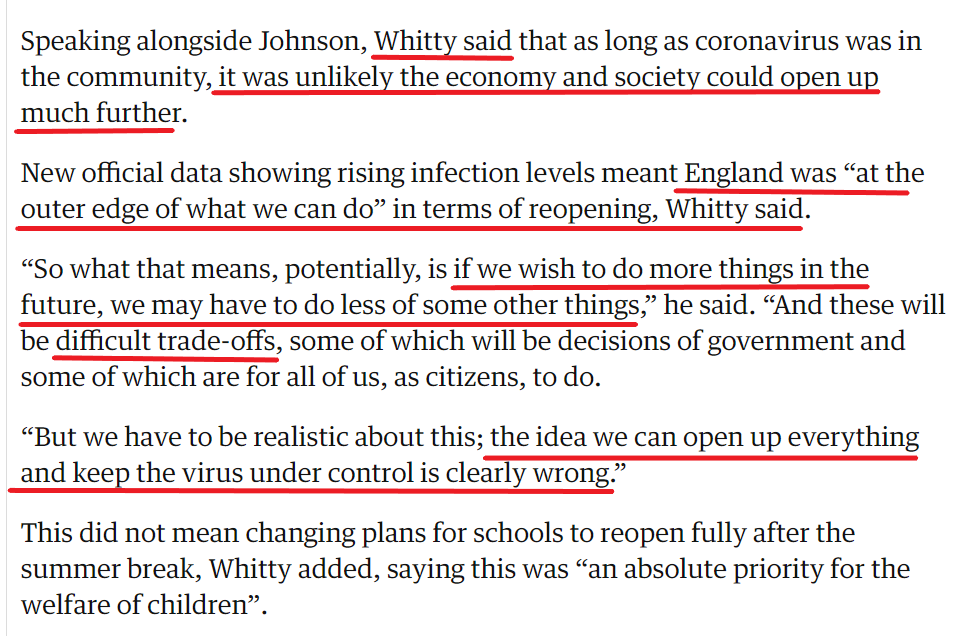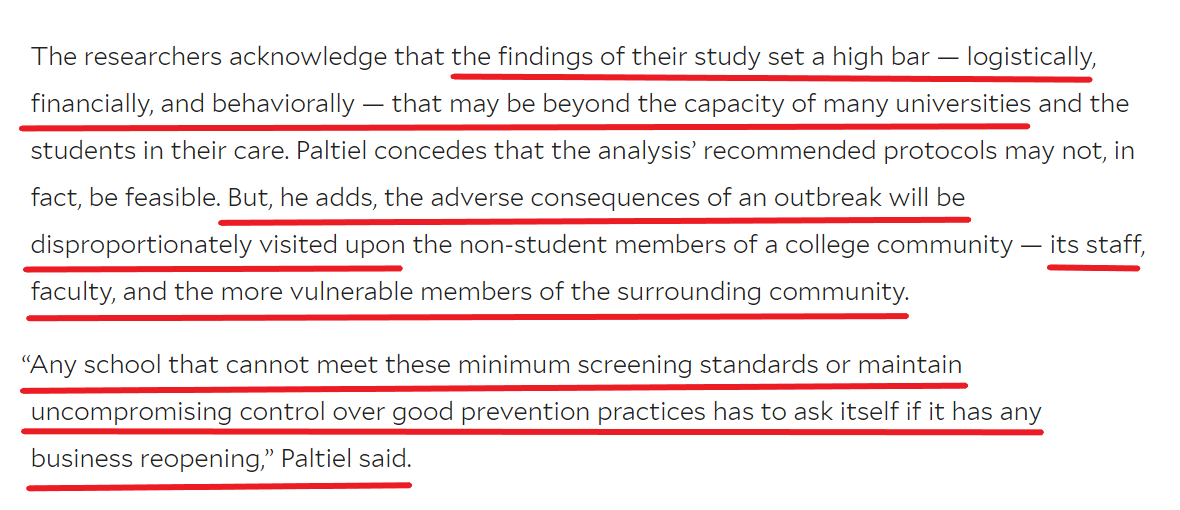https://consumer.healthday.com/infectious-disease-information-21/coronavirus-1008/college-students-will-need-covid-tests-every-2-3-days-for-campus-safety-study-760002.html">https://consumer.healthday.com/infectiou...
This according to @ADPaltiel, a Professor of health policy at @YaleSPH, in comments on epidemological modelling, for which he was lead investigator, published today in JAMA https://abs.twimg.com/emoji/v2/... draggable="false" alt="👇" title="Rückhand Zeigefinger nach unten" aria-label="Emoji: Rückhand Zeigefinger nach unten">. 2/ https://jamanetwork.com/journals/jamanetworkopen/fullarticle/2768923">https://jamanetwork.com/journals/...
https://abs.twimg.com/emoji/v2/... draggable="false" alt="👇" title="Rückhand Zeigefinger nach unten" aria-label="Emoji: Rückhand Zeigefinger nach unten">. 2/ https://jamanetwork.com/journals/jamanetworkopen/fullarticle/2768923">https://jamanetwork.com/journals/...
See further comments https://abs.twimg.com/emoji/v2/... draggable="false" alt="👇" title="Rückhand Zeigefinger nach unten" aria-label="Emoji: Rückhand Zeigefinger nach unten">by @ADPaltiel in above-linked press account. ("school" = "university") 3/
https://abs.twimg.com/emoji/v2/... draggable="false" alt="👇" title="Rückhand Zeigefinger nach unten" aria-label="Emoji: Rückhand Zeigefinger nach unten">by @ADPaltiel in above-linked press account. ("school" = "university") 3/
These findings are especially problematic, given these remarks of England& #39;s chief medical officer https://abs.twimg.com/emoji/v2/... draggable="false" alt="👇" title="Rückhand Zeigefinger nach unten" aria-label="Emoji: Rückhand Zeigefinger nach unten">. If @UniversitiesUK re-open to in-person teaching without 2-3 day testing, other things will need to close to keep the pandemic under control. 4/4
https://abs.twimg.com/emoji/v2/... draggable="false" alt="👇" title="Rückhand Zeigefinger nach unten" aria-label="Emoji: Rückhand Zeigefinger nach unten">. If @UniversitiesUK re-open to in-person teaching without 2-3 day testing, other things will need to close to keep the pandemic under control. 4/4
https://www.theguardian.com/world/2020/jul/31/coronavirus-boris-johnson-postpones-latest-round-of-lockdown-easing">https://www.theguardian.com/world/202...
https://www.theguardian.com/world/2020/jul/31/coronavirus-boris-johnson-postpones-latest-round-of-lockdown-easing">https://www.theguardian.com/world/202...
PS: The study published in JAMA is co-authored by 2 Harvard scientists & has informed the university& #39;s decision to test students every 3 days as a condition of opening their halls of residence to reduced capacity re-opening. See thread https://abs.twimg.com/emoji/v2/... draggable="false" alt="👇" title="Rückhand Zeigefinger nach unten" aria-label="Emoji: Rückhand Zeigefinger nach unten">. 1/ https://twitter.com/MikeOtsuka/status/1280568912573333504">https://twitter.com/MikeOtsuk...
https://abs.twimg.com/emoji/v2/... draggable="false" alt="👇" title="Rückhand Zeigefinger nach unten" aria-label="Emoji: Rückhand Zeigefinger nach unten">. 1/ https://twitter.com/MikeOtsuka/status/1280568912573333504">https://twitter.com/MikeOtsuk...
Note that Harvard Arts & Sciences doesn& #39;t even regard testing every 3 days as sufficient to ensure the safety of in-person teaching & will be conducting their teaching entirely online in 2020-21. 2/
One further comment on Harvard& #39;s approach https://abs.twimg.com/emoji/v2/... draggable="false" alt="👇" title="Rückhand Zeigefinger nach unten" aria-label="Emoji: Rückhand Zeigefinger nach unten">. 3/3 https://twitter.com/MikeOtsuka/status/1269362108422029317">https://twitter.com/MikeOtsuk...
https://abs.twimg.com/emoji/v2/... draggable="false" alt="👇" title="Rückhand Zeigefinger nach unten" aria-label="Emoji: Rückhand Zeigefinger nach unten">. 3/3 https://twitter.com/MikeOtsuka/status/1269362108422029317">https://twitter.com/MikeOtsuk...
Further comment by @ADPaltiel: Acknowledges challenge & expense of testing every 3 days but says that, given risks to faculty & staff, any university unwilling to test so frequently "has to ask itself if it has any business reopening". 1/
https://news.yale.edu/2020/07/31/students-need-be-tested-every-2-3-days-colleges-safely-reopen">https://news.yale.edu/2020/07/3...
https://news.yale.edu/2020/07/31/students-need-be-tested-every-2-3-days-colleges-safely-reopen">https://news.yale.edu/2020/07/3...
Disappointing that @UniversitiesUK employers have not explained why, in spite of these findings, they nevertheless think it possible safely to re-open campuses to in-person teaching in the absence of such frequent testing. They simply ignore this challenge. @jim_dickinson 2/2
Here I go a bit into the weeds of @ADPaltiel& #39;s modelling. JAMA paper says "This model did not identify symptom-based screening alone as sufficient to contain an outbreak under any of the scenarios we considered." See also https://abs.twimg.com/emoji/v2/... draggable="false" alt="👇" title="Rückhand Zeigefinger nach unten" aria-label="Emoji: Rückhand Zeigefinger nach unten">linked comments to the press. 1/
https://abs.twimg.com/emoji/v2/... draggable="false" alt="👇" title="Rückhand Zeigefinger nach unten" aria-label="Emoji: Rückhand Zeigefinger nach unten">linked comments to the press. 1/
https://consumer.healthday.com/infectious-disease-information-21/coronavirus-1008/college-students-will-need-covid-tests-every-2-3-days-for-campus-safety-study-760002.html">https://consumer.healthday.com/infectiou...
https://consumer.healthday.com/infectious-disease-information-21/coronavirus-1008/college-students-will-need-covid-tests-every-2-3-days-for-campus-safety-study-760002.html">https://consumer.healthday.com/infectiou...
As @ADPaltiel also notes https://abs.twimg.com/emoji/v2/... draggable="false" alt="👆" title="Rückhand Zeigefinger nach oben" aria-label="Emoji: Rückhand Zeigefinger nach oben">: "The reason [why testing of only those with symptoms is insufficient] is clear -- this virus can be transmitted by highly infectious asymptomatic silent spreaders". 2/
https://abs.twimg.com/emoji/v2/... draggable="false" alt="👆" title="Rückhand Zeigefinger nach oben" aria-label="Emoji: Rückhand Zeigefinger nach oben">: "The reason [why testing of only those with symptoms is insufficient] is clear -- this virus can be transmitted by highly infectious asymptomatic silent spreaders". 2/
On the basis of a number of cited papers, the model assumes "a 30% probability that infection would eventually lead to observable COVID-19–defining symptoms in this young cohort" -- i.e., 70% of those 18-30 years old who have Covid-19 infection never develop symptoms. 3/
JAMA also includes a response https://abs.twimg.com/emoji/v2/... draggable="false" alt="👇" title="Rückhand Zeigefinger nach unten" aria-label="Emoji: Rückhand Zeigefinger nach unten">to this paper, co-authored by @ehbvassar, a health economist who is President of Vassar College & past founder & Director of Yale Global Health Leadership Institute. 4/ https://jamanetwork.com/journals/jamanetworkopen/fullarticle/2768917">https://jamanetwork.com/journals/...
https://abs.twimg.com/emoji/v2/... draggable="false" alt="👇" title="Rückhand Zeigefinger nach unten" aria-label="Emoji: Rückhand Zeigefinger nach unten">to this paper, co-authored by @ehbvassar, a health economist who is President of Vassar College & past founder & Director of Yale Global Health Leadership Institute. 4/ https://jamanetwork.com/journals/jamanetworkopen/fullarticle/2768917">https://jamanetwork.com/journals/...
. @ehbvassar doesn& #39;t dispute @ADPaltiel& #39;s assertion that symptomatic testing is insufficient. But she argues that, for a small residential liberal arts college such as Vassar in a college town, testing all students (including asymptomatic) only every 4 weeks might be enough. 5/
What accounts for this difference? I think it& #39;s mainly that @ehbvassar believes Vassar College could improve on even the most optimistic of @ADPaltiel& #39;s three modelled scenarios (base, worst case, & best case). 6/
. @ADPaltiel& #39;s best case scenario assumes 10 new infections per week (from outside the student community) per 10,000 students. It also assumes an Rt of 1.5 (i.e., each infected student transmits to 1.5 others on average). 7/
By contrast, @ehbvassar assumes 4 new infections per week per 10,000 students "given that [Vassar students mainly live in halls of residence on campus and] we will limit student movement off campus and significantly reduce student interactions with faculty and employees". 8/
. @ehbvassar also assumes an Rt of 1.25 "given that we will have extensive social distancing, masking, and other measures". These measures are spelled out in more detail https://abs.twimg.com/emoji/v2/... draggable="false" alt="👇" title="Rückhand Zeigefinger nach unten" aria-label="Emoji: Rückhand Zeigefinger nach unten">. Note that they don& #39;t much address transmission among students in halls of residence & while socialising. 9/
https://abs.twimg.com/emoji/v2/... draggable="false" alt="👇" title="Rückhand Zeigefinger nach unten" aria-label="Emoji: Rückhand Zeigefinger nach unten">. Note that they don& #39;t much address transmission among students in halls of residence & while socialising. 9/
Presumably, students will be allowed to venture off campus in the evening. Assuming that the local bars are allowed to remain open, the risks of super-spreader events such as this https://abs.twimg.com/emoji/v2/... draggable="false" alt="👇" title="Rückhand Zeigefinger nach unten" aria-label="Emoji: Rückhand Zeigefinger nach unten">will remain, even w social distancing. 10/ https://twitter.com/MikeOtsuka/status/1284758183521726464">https://twitter.com/MikeOtsuk...
https://abs.twimg.com/emoji/v2/... draggable="false" alt="👇" title="Rückhand Zeigefinger nach unten" aria-label="Emoji: Rückhand Zeigefinger nach unten">will remain, even w social distancing. 10/ https://twitter.com/MikeOtsuka/status/1284758183521726464">https://twitter.com/MikeOtsuk...
Even if the bars of Poughkeepsie, New York, are all shut down, student will mix & socialise. There will be house parties https://abs.twimg.com/emoji/v2/... draggable="false" alt="👇" title="Rückhand Zeigefinger nach unten" aria-label="Emoji: Rückhand Zeigefinger nach unten">. It& #39;s also possible that some will sleep with one another. @ehbvassar will not be able to impose & enforce monastic vows. 11/ https://twitter.com/MikeOtsuka/status/1285814841169584133">https://twitter.com/MikeOtsuk...
https://abs.twimg.com/emoji/v2/... draggable="false" alt="👇" title="Rückhand Zeigefinger nach unten" aria-label="Emoji: Rückhand Zeigefinger nach unten">. It& #39;s also possible that some will sleep with one another. @ehbvassar will not be able to impose & enforce monastic vows. 11/ https://twitter.com/MikeOtsuka/status/1285814841169584133">https://twitter.com/MikeOtsuk...
For the reasons spelled out https://abs.twimg.com/emoji/v2/... draggable="false" alt="👆" title="Rückhand Zeigefinger nach oben" aria-label="Emoji: Rückhand Zeigefinger nach oben">, & in this thread
https://abs.twimg.com/emoji/v2/... draggable="false" alt="👆" title="Rückhand Zeigefinger nach oben" aria-label="Emoji: Rückhand Zeigefinger nach oben">, & in this thread https://abs.twimg.com/emoji/v2/... draggable="false" alt="👇" title="Rückhand Zeigefinger nach unten" aria-label="Emoji: Rückhand Zeigefinger nach unten">, an Rt as low as 1.25 for students in residence stretches credulity. @ADPaltiel& #39;s best case scenario of Rt of 1.5 is more credible. (Note that "dorm" is American for UK "hall of residence".) 12/ https://twitter.com/gregggonsalves/status/1278368955044782081">https://twitter.com/gregggons...
https://abs.twimg.com/emoji/v2/... draggable="false" alt="👇" title="Rückhand Zeigefinger nach unten" aria-label="Emoji: Rückhand Zeigefinger nach unten">, an Rt as low as 1.25 for students in residence stretches credulity. @ADPaltiel& #39;s best case scenario of Rt of 1.5 is more credible. (Note that "dorm" is American for UK "hall of residence".) 12/ https://twitter.com/gregggonsalves/status/1278368955044782081">https://twitter.com/gregggons...
What about @ehbvassar& #39;s assumption of only 4 new infections per 10k per week from outside the student community, rather than @ADPaltiel& #39;s best case of 10 per week? 13/
. @ADPaltiel calls these new infections "exogenous shocks" & describes how they might arise https://abs.twimg.com/emoji/v2/... draggable="false" alt="👇" title="Rückhand Zeigefinger nach unten" aria-label="Emoji: Rückhand Zeigefinger nach unten">. 14/
https://abs.twimg.com/emoji/v2/... draggable="false" alt="👇" title="Rückhand Zeigefinger nach unten" aria-label="Emoji: Rückhand Zeigefinger nach unten">. 14/
The above-mentioned super-spreader event in the East Lansing bar is one good example of an "exogenous shock". It& #39;s not clear how @ehbvassar will manage to "limit student movement off campus" to prevent this. 15/
The number of new infections per week from outside the student population will also crucially depend on the general rate of infections in the surrounding community. 16/
In England, this has been rising in recent weeks as things have re-opened. We can infer from the latest ONS figures that the general rate in England is now about 5.5 new infections per week per 10,000 people. 17/
https://www.ons.gov.uk/peoplepopulationandcommunity/healthandsocialcare/conditionsanddiseases/bulletins/coronaviruscovid19infectionsurveypilot/31july2020">https://www.ons.gov.uk/peoplepop...
https://www.ons.gov.uk/peoplepopulationandcommunity/healthandsocialcare/conditionsanddiseases/bulletins/coronaviruscovid19infectionsurveypilot/31july2020">https://www.ons.gov.uk/peoplepop...
This rate has also been almost twice as high among those 18-49 years old, in comparison with other age groups. 18/
Absent, therefore, significant reduction in general rate of infection in England this autumn -- contrary to prediction colder weather & school re-openings will lead to a rise -- it& #39;s unrealistic to assume better than @ADPaltiel& #39;s best case 10 per 10k weekly new infections. 19/
Upshot: What @ADPaltiel say here https://abs.twimg.com/emoji/v2/... draggable="false" alt="👇" title="Rückhand Zeigefinger nach unten" aria-label="Emoji: Rückhand Zeigefinger nach unten">, in the very first tweet of this thread, applies to universities in England & not just the US. 20/ https://twitter.com/MikeOtsuka/status/1289243511414558721">https://twitter.com/MikeOtsuk...
https://abs.twimg.com/emoji/v2/... draggable="false" alt="👇" title="Rückhand Zeigefinger nach unten" aria-label="Emoji: Rückhand Zeigefinger nach unten">, in the very first tweet of this thread, applies to universities in England & not just the US. 20/ https://twitter.com/MikeOtsuka/status/1289243511414558721">https://twitter.com/MikeOtsuk...
. @UniversitiesUK @UCEA1 @RussellGroup @AlistairJarvis
& other university leaders in this nation: This modelling merits a response. Please stop pretending it doesn& #39;t exist. As @gregggonsalves said of an earlier draft of the JAMA paper https://abs.twimg.com/emoji/v2/... draggable="false" alt="👇" title="Rückhand Zeigefinger nach unten" aria-label="Emoji: Rückhand Zeigefinger nach unten">. 21/ https://twitter.com/gregggonsalves/status/1280560141952331777">https://twitter.com/gregggons...
https://abs.twimg.com/emoji/v2/... draggable="false" alt="👇" title="Rückhand Zeigefinger nach unten" aria-label="Emoji: Rückhand Zeigefinger nach unten">. 21/ https://twitter.com/gregggonsalves/status/1280560141952331777">https://twitter.com/gregggons...
& other university leaders in this nation: This modelling merits a response. Please stop pretending it doesn& #39;t exist. As @gregggonsalves said of an earlier draft of the JAMA paper
You owe it to your students, your staff & the residents of the communities in which you& #39;re located to explain how you& #39;ve established the safety of re-opening universities in the autumn in the absence of regular & frequent testing of students, asymptomatic & symptomatic. 22/22
PS: In early July I asked these questions https://abs.twimg.com/emoji/v2/... draggable="false" alt="👇" title="Rückhand Zeigefinger nach unten" aria-label="Emoji: Rückhand Zeigefinger nach unten">re pre-print of the @ADPaltiel et al study. No explanation for why this isn& #39;t necessary here. I hope @markmleach @jim_dickinson @jgro_the @RichardA @sweale or @branwenjeffreys might be able to elicit explanation. https://twitter.com/MikeOtsuka/status/1280568912573333504">https://twitter.com/MikeOtsuk...
https://abs.twimg.com/emoji/v2/... draggable="false" alt="👇" title="Rückhand Zeigefinger nach unten" aria-label="Emoji: Rückhand Zeigefinger nach unten">re pre-print of the @ADPaltiel et al study. No explanation for why this isn& #39;t necessary here. I hope @markmleach @jim_dickinson @jgro_the @RichardA @sweale or @branwenjeffreys might be able to elicit explanation. https://twitter.com/MikeOtsuka/status/1280568912573333504">https://twitter.com/MikeOtsuk...
Shockingly weak @UniversitiesUK statement of Covid safety measures all unis will adopt, in linked piece by @AnnaFazack1. No mention of testing, ventilation or face masks. Only hand sanitisers, cleaning & 1-way & 2m markings. @AlistairJarvis, is that it!?
https://www.theguardian.com/education/2020/aug/01/uk-universities-putting-finances-above-student-safety-expert-warns">https://www.theguardian.com/education...
https://www.theguardian.com/education/2020/aug/01/uk-universities-putting-finances-above-student-safety-expert-warns">https://www.theguardian.com/education...
For evidence relevant to above modelling assumptions regarding rate of infection among university-aged, see this graph https://abs.twimg.com/emoji/v2/... draggable="false" alt="👇" title="Rückhand Zeigefinger nach unten" aria-label="Emoji: Rückhand Zeigefinger nach unten">of prevalence of confirmed infections in Spain among ages 15-29, since easing of lockdown.
https://abs.twimg.com/emoji/v2/... draggable="false" alt="👇" title="Rückhand Zeigefinger nach unten" aria-label="Emoji: Rückhand Zeigefinger nach unten">of prevalence of confirmed infections in Spain among ages 15-29, since easing of lockdown.
https://www.bloomberg.com/opinion/articles/2020-07-28/what-spain-is-telling-us-about-second-wave-of-coronavirus">https://www.bloomberg.com/opinion/a...
https://www.bloomberg.com/opinion/articles/2020-07-28/what-spain-is-telling-us-about-second-wave-of-coronavirus">https://www.bloomberg.com/opinion/a...
In a plan & #39;typical& #39; of large US state universities, UC Berkeley will test all residential students on arrival, followed by 7-10 day quarantine in single dorm room, then re-test to confirm Covid-negative status. Separate dorm for those who test positive. 1/
https://www.nytimes.com/2020/08/02/us/covid-college-reopening.html">https://www.nytimes.com/2020/08/0...
https://www.nytimes.com/2020/08/02/us/covid-college-reopening.html">https://www.nytimes.com/2020/08/0...
Followed by planned testing 2x month of all students in halls of residence. Are any @UniversitiesUK employers planning such initial testing & quarantine for ALL students in residence? Regular testing later? Single rooms for all? Separate hall for quarantine? If not, why not? 2/2
Significant UK developments regarding testing described in this government press release & #39;Roll-out of 2 new rapid coronavirus tests ahead of winter& #39;. 1/ https://www.gov.uk/government/news/roll-out-of-2-new-rapid-coronavirus-tests-ahead-of-winter">https://www.gov.uk/governmen...
Further information on today& #39;s @BBCr4today:
--Interview w John Bell, Oxford’s Regius Professor of Medicine, starting at 7:13 am.
--Piece starting at 6:10 am.
--Interview with a government minister from 8:22 am. 2/
--Interview w John Bell, Oxford’s Regius Professor of Medicine, starting at 7:13 am.
--Piece starting at 6:10 am.
--Interview with a government minister from 8:22 am. 2/
In a few hours, and for the next month, these will be available to listen to here https://abs.twimg.com/emoji/v2/... draggable="false" alt="👇" title="Rückhand Zeigefinger nach unten" aria-label="Emoji: Rückhand Zeigefinger nach unten">. 3/ https://www.bbc.co.uk/programmes/b006qj9z/episodes/player">https://www.bbc.co.uk/programme...
https://abs.twimg.com/emoji/v2/... draggable="false" alt="👇" title="Rückhand Zeigefinger nach unten" aria-label="Emoji: Rückhand Zeigefinger nach unten">. 3/ https://www.bbc.co.uk/programmes/b006qj9z/episodes/player">https://www.bbc.co.uk/programme...
Information gleaned from the above:
 https://abs.twimg.com/emoji/v2/... draggable="false" alt="✅" title="Fettes weißes Häkchen" aria-label="Emoji: Fettes weißes Häkchen">The test can be based on saliva (either throat swab or spit into a cup) rather than somewhat intrusive & unpleasant nasal swab.
https://abs.twimg.com/emoji/v2/... draggable="false" alt="✅" title="Fettes weißes Häkchen" aria-label="Emoji: Fettes weißes Häkchen">The test can be based on saliva (either throat swab or spit into a cup) rather than somewhat intrusive & unpleasant nasal swab.
 https://abs.twimg.com/emoji/v2/... draggable="false" alt="✅" title="Fettes weißes Häkchen" aria-label="Emoji: Fettes weißes Häkchen">It can test for the flu as well as Covid-19. 4/
https://abs.twimg.com/emoji/v2/... draggable="false" alt="✅" title="Fettes weißes Häkchen" aria-label="Emoji: Fettes weißes Häkchen">It can test for the flu as well as Covid-19. 4/
See this piece by @ashishkjha, Professor of Global Health at @HarvardHSPH, on why frequency of testing & rapidity of results is much more important than accuracy of result per test. 1/ https://time.com/5873444/radically-rethink-covid-19-testing-approach/">https://time.com/5873444/r...
See also this paper by @michaelmina_lab (et al), to whom @ashishkjha refers, whose title says it all: "Test sensitivity is secondary to frequency and turnaround time for COVID-19 surveillance". 2/2 https://www.medrxiv.org/content/10.1101/2020.06.22.20136309v2">https://www.medrxiv.org/content/1...

 Read on Twitter
Read on Twitter by @ADPaltiel in above-linked press account. ("school" = "university") 3/" title="See further commentshttps://abs.twimg.com/emoji/v2/... draggable="false" alt="👇" title="Rückhand Zeigefinger nach unten" aria-label="Emoji: Rückhand Zeigefinger nach unten">by @ADPaltiel in above-linked press account. ("school" = "university") 3/" class="img-responsive" style="max-width:100%;"/>
by @ADPaltiel in above-linked press account. ("school" = "university") 3/" title="See further commentshttps://abs.twimg.com/emoji/v2/... draggable="false" alt="👇" title="Rückhand Zeigefinger nach unten" aria-label="Emoji: Rückhand Zeigefinger nach unten">by @ADPaltiel in above-linked press account. ("school" = "university") 3/" class="img-responsive" style="max-width:100%;"/>
 . If @UniversitiesUK re-open to in-person teaching without 2-3 day testing, other things will need to close to keep the pandemic under control. 4/4 https://www.theguardian.com/world/202..." title="These findings are especially problematic, given these remarks of England& #39;s chief medical officerhttps://abs.twimg.com/emoji/v2/... draggable="false" alt="👇" title="Rückhand Zeigefinger nach unten" aria-label="Emoji: Rückhand Zeigefinger nach unten">. If @UniversitiesUK re-open to in-person teaching without 2-3 day testing, other things will need to close to keep the pandemic under control. 4/4 https://www.theguardian.com/world/202..." class="img-responsive" style="max-width:100%;"/>
. If @UniversitiesUK re-open to in-person teaching without 2-3 day testing, other things will need to close to keep the pandemic under control. 4/4 https://www.theguardian.com/world/202..." title="These findings are especially problematic, given these remarks of England& #39;s chief medical officerhttps://abs.twimg.com/emoji/v2/... draggable="false" alt="👇" title="Rückhand Zeigefinger nach unten" aria-label="Emoji: Rückhand Zeigefinger nach unten">. If @UniversitiesUK re-open to in-person teaching without 2-3 day testing, other things will need to close to keep the pandemic under control. 4/4 https://www.theguardian.com/world/202..." class="img-responsive" style="max-width:100%;"/>

 linked comments to the press. 1/ https://consumer.healthday.com/infectiou..." title="Here I go a bit into the weeds of @ADPaltiel& #39;s modelling. JAMA paper says "This model did not identify symptom-based screening alone as sufficient to contain an outbreak under any of the scenarios we considered." See alsohttps://abs.twimg.com/emoji/v2/... draggable="false" alt="👇" title="Rückhand Zeigefinger nach unten" aria-label="Emoji: Rückhand Zeigefinger nach unten">linked comments to the press. 1/ https://consumer.healthday.com/infectiou..." class="img-responsive" style="max-width:100%;"/>
linked comments to the press. 1/ https://consumer.healthday.com/infectiou..." title="Here I go a bit into the weeds of @ADPaltiel& #39;s modelling. JAMA paper says "This model did not identify symptom-based screening alone as sufficient to contain an outbreak under any of the scenarios we considered." See alsohttps://abs.twimg.com/emoji/v2/... draggable="false" alt="👇" title="Rückhand Zeigefinger nach unten" aria-label="Emoji: Rückhand Zeigefinger nach unten">linked comments to the press. 1/ https://consumer.healthday.com/infectiou..." class="img-responsive" style="max-width:100%;"/>
 . Note that they don& #39;t much address transmission among students in halls of residence & while socialising. 9/" title=". @ehbvassar also assumes an Rt of 1.25 "given that we will have extensive social distancing, masking, and other measures". These measures are spelled out in more detailhttps://abs.twimg.com/emoji/v2/... draggable="false" alt="👇" title="Rückhand Zeigefinger nach unten" aria-label="Emoji: Rückhand Zeigefinger nach unten">. Note that they don& #39;t much address transmission among students in halls of residence & while socialising. 9/" class="img-responsive" style="max-width:100%;"/>
. Note that they don& #39;t much address transmission among students in halls of residence & while socialising. 9/" title=". @ehbvassar also assumes an Rt of 1.25 "given that we will have extensive social distancing, masking, and other measures". These measures are spelled out in more detailhttps://abs.twimg.com/emoji/v2/... draggable="false" alt="👇" title="Rückhand Zeigefinger nach unten" aria-label="Emoji: Rückhand Zeigefinger nach unten">. Note that they don& #39;t much address transmission among students in halls of residence & while socialising. 9/" class="img-responsive" style="max-width:100%;"/>
 . 14/" title=". @ADPaltiel calls these new infections "exogenous shocks" & describes how they might arisehttps://abs.twimg.com/emoji/v2/... draggable="false" alt="👇" title="Rückhand Zeigefinger nach unten" aria-label="Emoji: Rückhand Zeigefinger nach unten">. 14/" class="img-responsive" style="max-width:100%;"/>
. 14/" title=". @ADPaltiel calls these new infections "exogenous shocks" & describes how they might arisehttps://abs.twimg.com/emoji/v2/... draggable="false" alt="👇" title="Rückhand Zeigefinger nach unten" aria-label="Emoji: Rückhand Zeigefinger nach unten">. 14/" class="img-responsive" style="max-width:100%;"/>

 of prevalence of confirmed infections in Spain among ages 15-29, since easing of lockdown. https://www.bloomberg.com/opinion/a..." title="For evidence relevant to above modelling assumptions regarding rate of infection among university-aged, see this graphhttps://abs.twimg.com/emoji/v2/... draggable="false" alt="👇" title="Rückhand Zeigefinger nach unten" aria-label="Emoji: Rückhand Zeigefinger nach unten">of prevalence of confirmed infections in Spain among ages 15-29, since easing of lockdown. https://www.bloomberg.com/opinion/a..." class="img-responsive" style="max-width:100%;"/>
of prevalence of confirmed infections in Spain among ages 15-29, since easing of lockdown. https://www.bloomberg.com/opinion/a..." title="For evidence relevant to above modelling assumptions regarding rate of infection among university-aged, see this graphhttps://abs.twimg.com/emoji/v2/... draggable="false" alt="👇" title="Rückhand Zeigefinger nach unten" aria-label="Emoji: Rückhand Zeigefinger nach unten">of prevalence of confirmed infections in Spain among ages 15-29, since easing of lockdown. https://www.bloomberg.com/opinion/a..." class="img-responsive" style="max-width:100%;"/>



